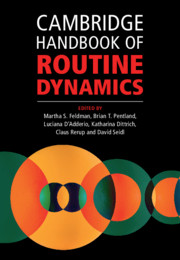Book contents
- Cambridge Handbook of Routine Dynamics
- Cambridge Handbook of Routine Dynamics
- Copyright page
- Contents
- Figures
- Tables
- Contributors
- Preface
- Chapter 1 What Is Routine Dynamics?
- Part I Theoretical Resources for Routine Dynamics Research
- Chapter 2 Practice Theory and Routine Dynamics
- Chapter 3 Process Theorizing and Routine Dynamics
- Chapter 4 Ethnomethodology and Routine Dynamics
- Chapter 5 Pragmatism and Routine Dynamics
- Chapter 6 Actor-Network Theory and Routine Dynamics
- Chapter 7 Materiality and Routine Dynamics
- Part II Methodological Issues in Routine Dynamics Research
- Part III Themes in Routine Dynamics Research
- Part IV Related Communities of Thought
- Author Index
- Subject Index
- References
Chapter 4 - Ethnomethodology and Routine Dynamics
from Part I - Theoretical Resources for Routine Dynamics Research
Published online by Cambridge University Press: 11 December 2021
- Cambridge Handbook of Routine Dynamics
- Cambridge Handbook of Routine Dynamics
- Copyright page
- Contents
- Figures
- Tables
- Contributors
- Preface
- Chapter 1 What Is Routine Dynamics?
- Part I Theoretical Resources for Routine Dynamics Research
- Chapter 2 Practice Theory and Routine Dynamics
- Chapter 3 Process Theorizing and Routine Dynamics
- Chapter 4 Ethnomethodology and Routine Dynamics
- Chapter 5 Pragmatism and Routine Dynamics
- Chapter 6 Actor-Network Theory and Routine Dynamics
- Chapter 7 Materiality and Routine Dynamics
- Part II Methodological Issues in Routine Dynamics Research
- Part III Themes in Routine Dynamics Research
- Part IV Related Communities of Thought
- Author Index
- Subject Index
- References
Summary
Ethnomethodology (EM) has been fundamental to Routine Dynamics theorizing since its inception. However, whereas EM is well known for its detailed studies of face-to-face interactions, its relevance to understanding phenomena such as routines that span multiple spaces and times is less widely recognized. EM studies of routine dynamics take a primary interest in the taken-for-granted yet systematic ways in which members produce actions that are accountably “the same” across sites and occasions. Through sequenced embodied displays of orientation to material elements of the setting and the unfolding interaction, members construct in situ an interaction that is meaningful to them. To the extent that some such elements are available and oriented-to by actors across multiple sites and occasions, a pattern of repetitive action becomes observable. EM thus provides the theoretical underpinning for an understanding of routines as situated actions, and paves the way for a program of routine dynamics research grounded in the empirically observable material and embodied processes of interaction that constitute repetitive action patterns.
Information
- Type
- Chapter
- Information
- Cambridge Handbook of Routine Dynamics , pp. 49 - 61Publisher: Cambridge University PressPrint publication year: 2021
References
Accessibility standard: Unknown
Why this information is here
This section outlines the accessibility features of this content - including support for screen readers, full keyboard navigation and high-contrast display options. This may not be relevant for you.Accessibility Information
- 9
- Cited by
